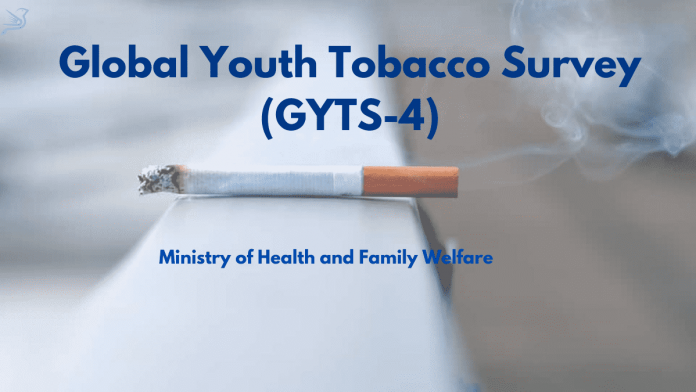Hello Aspirants!
As you may know, the Ministry of Health and Family Welfare (MoHFW) has recently released the fourth round of Global Youth Tobacco Survey (GYTS-4).
To know more about it let’s first understand what it is all about.
What is the Global Youth Tobacco Survey (GYTS)?
- The World Health Organization (WHO) collaborated with the Tobacco Free Initiative (TFI) that initiated this proposal, the United Nations Children’s Fund (UNICEF) and the Office on Smoking and Health at the Centres for Disease Control and Prevention (OSH-CDC), together developed the Global Youth Tobacco Survey (GYTS).
- It is a standard instrument to assess and monitor the tobacco situation and its impact among the youths between 13–15 years of age, studying in 8 to 10 grades.
- GYTS provides an estimate of tobacco prevalence at national and state levels by sex and location.
GYTS in India:
- In India, three rounds of the GYTS have been conducted in the past. The first round was conducted at the state level during 2000–2005 and the other two rounds were conducted in 2006 and 2009 expanded to national-level surveys.
- For the current 2019 round, International Institute for Population Sciences (IIPS) was appointed by MoHFW as the nodal agency.
- IIPS was established in July 1956 in Mumbai. It was formerly known as the Demographic Training and Research Centre (DTRC) till 1970 established under the joint sponsorship of Sir Dorabji Tata Trust, the Government of India (GOI) and the United Nations.
- It acts as a regional centre for Training and Research in Population Studies for the the Economic and Social Commission for Asia and the Pacific (ESCAP) region.
- The survey was developed to produce national estimates of tobacco use among school going children aged between 13 to 15 years at the level of state and Union Territory (UT).
- It was conducted under criterias like sex, location of school (rural-urban), and management of school (public-private).
- In total, 97,302 students participated in the survey from 987 schools.
Major topics of survey:
- Information on tobacco use,
- Cessation (reducation),
- Second-hand smoke,
- Access and availability,
- Exposure to anti-tobacco information,
- Awareness about tobacco marketing, knowledge, and attitudes.
GYTS-4 major Findings:
- Decline in Tobacco Use:
The survey shows a 42% decline in tobacco use among 13-15 year-old school going children in the last decade.
One-fifth of the students between the age of 13-15 used any form of the tobacco product (smoking, smokeless, or any other form) in their life.
- Initiation Age:
38% of cigarettes, 47% of bidi smokers and 52% of smokeless tobacco users started using tobacco before their tenth birthday.
The median age of initiation of cigarette, bidi, and smokeless tobacco were 11.5 years, 10.5 years and 9.9 years respectively.
- Gender Based Usage:
Use of any form of tobacco was higher among boys.
Prevalence of tobacco use among boys was 9.6% and among girls was 7.4%.
- State Wise Data:
Tobacco use among school going children was highest in Arunachal Pradesh and Mizoram while it was lowest in Himachal Pradesh and Karnataka.
| Highest | Arunachal Pradesh, Mizoram |
| Lowest | Himachal Pradesh, Karnataka |
- Awareness rate:
52% of the students noticed anti-tobacco messages in the mass media.
18% of the students noticed tobacco advertisements or promotions at the vendor’s place when they went to purchase tobacco.
85% of school heads were aware of the Cigarettes and Other Tobacco Products Act (COTPA), 2003.
83% of schools were aware about the policy to display ‘tobacco-free school’ boards.
71% of the students thought other people smoking cigarettes is harmful to them.
58% of the students favoured a ban on smoking inside enclosed public places.
- Other findings:
The survey showed that at least 29.5% of the students are exposed to second-hand smoke with a 23.4% at outdoor public places, 21.2% inside enclosed public places and 11.2% at home.
The prevalence of smoking tobacco was 7.3% and in the case of smokeless tobacco products, the prevalence was 4.1%.
Every use of e-cigarette among the students was 2.8%.
Measures towards Tobacco Control in India:
- Adoption of WHO FCTC:
Firstly, India adopted the tobacco control provisions under World Health Organisation (WHO) Framework Convention on Tobacco Control (WHO FCTC).
- COTPA, 2003:
It replaced the Cigarettes Act of 1975 that was limited to statutory warnings like ‘Cigarette Smoking is Injurious to Health’ on cigarette packs and advertisements. It did not include non-cigarettes.
The revised 2003 Act also included cigars, bidis, pipe tobacco, cheroots, hookah, pan masala, chewing tobacco and gutka.
- Prohibition of Electronic Cigarettes Ordinance, 2019:
It prohibits the production, manufacture, import, export, transport, sale, distribution, storage and advertisement of e-Cigarettes.
- mCessation Programme:
This initiative uses mobile technology for tobacco cessation.
India launched mCessation Programme using text messages in 2016 as part of the Digital India initiative.
- National Tobacco Quitline Services (NTQLS):
It provides telephone-based information, advice, support, and referrals for cessation in tobacco use.
Global Initiatives on Tobacco control:
- The world celebrates World No Tobacco Day on 31st May.
- The WHO Framework Convention on Tobacco Control pushes governments across the world to adopt and implement the tobacco control provisions of the WHO Framework Convention on Tobacco Control (WHO FCTC).
This sums up the Global Youth Tobacco survey-4. Overall it is a major step towards reducing the use of tobacco among the youth for their better future.
We hope this article was helpful in increasing your understanding of GYTS.
Thank You!




